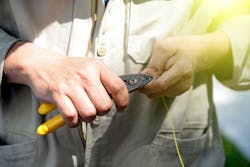In my April Broadband Technology Report column, I discussed how two of the four largest U.S. cable operators—Charter Communications and Altice USA—are plowing ahead with fiber-to-the-premises (FTTP) deployments. Despite recession concerns, rising labor costs, and continued supply-chain shortages, big MSOs embrace fiber-network builds like never before.
But, as I pointed out in earlier columns, the cable industry’s current fiber frenzy is not limited to just a few significant players. As several industry analysts have observed, smaller, nimbler cablecos are pivoting to fiber networks and PON technology faster and in more significant numbers than their bigger brethren.
“We continue to see a growing number of North American cable operators – particularly tier 2 and tier 3 operators – overbuilding their existing HFC (hybrid fiber-coax) networks with fiber,” noted Jeff Heynen, vice president of broadband access and home networking for Dell’Oro group, in an email. “Some of this activity is reflected in the purchase of Remote OLT [optical light terminal] platforms and modules, for which global revenue is expected to exceed $100 million in 2023 easily. Although much of that is driven by Charter’s RDOF [Rural Digital Opportunity Fund] buildouts, an increasing percentage will be for tier 2 and tier 3 overbuild projects.”
Tier 2 and 3 providers ramp fiber
Examples of such tier 2 and tier 3 fiber builds abound.
Take Armstrong Communications. Over the past few years, Armstrong, the 11th largest cable operator in the United States -- with systems in Pennsylvania, Ohio, New York, West Virginia, Kentucky, and Maryland -- has shifted from upgrading its HFC lines to building new FTTP networks. Working with Adtran as its leading equipment supplier, Armstrong is now moving from GPON to XGS-PON technology as it deploys fiber lines across its six-state territory.
“Over the past 15 years, Armstrong has evolved toward a fiber-to-the-premise architecture to support many wavelengths of light on the same glass,” said Mike Giobbi, then Armstrong CTO, in a written statement (he’s since retired). “We are now overlaying XGS-PON technology with the capacity of symmetrical 10 Gbit/s downstream and upstream on the same fiber strand into homes and businesses with GPON.”
Or take Blue Ridge Communications, whose HFC lines pass more than 200,000 homes in northeastern Pennsylvania. Blue Ridge has spent the last couple of years rebuilding and replacing its 8,000 miles of HFC plant with all-fiber networks in conjunction with its leading technology vendor, Calix.
“We believe the need for speed and bandwidth will continue to increase as more and more people work, learn, and are entertained at home,” said Mark Masenheiner, vice president of operations for Blue Ridge, in a written statement. “Fiber allows for ultrafast symmetrical speeds, increased network reliability, and the added environmental benefits of lower power consumption. It is the next logical step in the evolution of our network.”
Or take Midco. The midsized cableco, which serves more than 400,000 customers in five upper Midwest states (Minnesota, Wisconsin, Kansas, and the Dakotas), is prepping for the fiber future even as it continues to upgrade its legacy HFC plant for new and improved versions of DOCSIS.
As part of its network evolution strategy, Midco has started deploying FTTP to more than 65,000 homes and businesses in the Lawrence, Kan., area and offering 10-gig services over those lines using 10G EPON technology. Midco initially focused on deploying FTTP in its most competitive markets and targeting PON services for high-bandwidth customers. But it’s also laying fiber in all its new service areas.
“Midco plans to continue to deploy more fiber with a mix that makes sense,” Pao Lo, the company’s vice president of network engineering, wrote in an email. “Greenfield is 100% FTTP and brownfield is a mix of mid-splits and FTTP deployments and varies by area.”
Or take GCI. The midsized cable operator, Alaska’s largest service provider with slightly over 157,000 broadband subscribers, is now installing fiber at a steady clip in its urban and rural markets. It’s even deploying FTTP and EPON to scattered villages on the remote Aleutian Islands on the southwestern edge of the state.
“All of our greenfield opportunities are FTTP construction,” said Erik Kuhlmann, senior director of engineering and architecture for GCI. “That’s our starting point going forward.”
I could cite many more examples, such as Schurz Communications, which operates broadband systems in six states (Arizona, Iowa, Maryland, Minnesota, Ohio, and Vermont), and Troy Cable, a smaller operator in southeastern Alabama. But I think you get the picture. Whether they are deploying GPON, EPON, XGS-PON, or 10G EPON, small and midsized cablecos are flocking to fiber like flies to honey.
“We’ve got dozens of these small to midsized operators [as customers] that have moved to a fiber future,” said Robert Conger, senior vice president of technology and strategy for Adtran. “We’ve only seen it pick up over the last few years.”
Future-proofed platform
So why are so many smaller operators embracing fiber builds? Simply put, they do so for many of the same reasons as the bigger cablecos.
For one thing, smaller operators see the obvious bandwidth advantages of fiber networks, which can currently offer symmetrical speeds as high as 10 Gbps using the latest XGS-PON and 10G EPON standards and have the potential to deliver much higher speeds under the emerging 25G, 50G, and 100G PON specs.
“There are known advantages of fiber, such as higher symmetrical speeds and lower latent networks,” Midco’s Lo observed in his email note. “Ultimately, fiber does scale better over the long run as the industry is already discussing 25 GS PON, 50/100G GPON.”
FTTP networks are significantly cheaper to operate and maintain than HFC or copper networks because fiber lines require fewer active devices and are more reliable than coax—estimates of the operational cost savings achieved from deploying fiber run as high as 40% or more.
“It’s definitely less [costly] and substantially so,” noted Victor Esposito, recently appointed senior vice president of engineering and network operations at Ritter Communications after serving as vice president of engineering and architecture at GCI. “There’s a lot less [plant] maintenance required on the fiber side.”
Thanks to this attribute, Ritter is extending fiber to about 40,000 new locations each year. The smaller operator serves 48,000 broadband customers in Arkansas, Texas, Missouri, and Tennessee. “We’re planning to build out [fiber] to unserved and underserved communities adjacent to our existing portfolio,” Esposito said.
Other cable tech executives stress this point too. Indeed, the overall cost equation for fiber network builds appears to be favorable even though it usually still costs more to deploy FTTP initially than to upgrade legacy HFC networks to higher orders of DOCSIS. “The upfront cost to deploy FTTP is [still] higher than the DOCSIS upgrades,” Lo wrote in his email. “[But] where we have deployed FTTP, we have seen operational expense savings more favorable from FTTP areas than DOCSIS areas.”
Further, fiber provides a more future-proof broadband platform than coax. Once they install FTTP, providers can keep upgrading to ever-newer versions of PON technology without overhauling their existing networks, unlike what must be done with each new version of DOCSIS.
“It’s just easier to scale,” Conger noted. “Any upgrades are pretty simple.”
That’s particularly important for operators like GCI, which must find ways to keep its broadband service humming along in Alaska’s frigid, icy climate. As part of its network upgrade strategy, the cable operator is replacing its old, worn-out coax and copper plant with fresh, more resilient, longer-lasting fiber lines.
“We are finding that the [legacy] HFC is in much worse condition than we anticipated,” Kuhlmann said. He noted that fiber is “more robust in the Arctic environment” and offers a longer shelf life than either copper or coax.
Moreover, smaller cablecos are pivoting to fiber because, unlike their bigger sisters, they don’t have nearly as many legacy plant to rip out and replace. As a result, they have greater flexibility to shift from HFC to FTTP networks quickly and efficiently.
“Smaller operators don’t necessarily have either an existing fiber infrastructure or major organizational silos, which has allowed them to pivot to the use of 10G GPON,” wrote Jaimie Lenderman, a principal analyst at Omdia who has charted numerous FTTP deployments by smaller operators. “I think something important to remember is there are technology-agnostic solutions available, meaning operators can utilize their existing EPON or GPON networks, making vendor choice less arduous.”
Environmental benefits
Then there are the impressive environmental benefits of deploying fiber. In my BTR column last month, I cited a recent FBA study that calculated that moving all broadband households to fiber lines by 2030 would slash carbon dioxide (CO2) emissions by about 1.4 million metric tons annually.
Last but far from least, smaller cablecos are embracing fiber because of all the new government subsidy programs that favor FTTP builds. As I have noted before, the roster of major public subsidy programs includes the U.S. Treasury Department’s Capital Projects Fund ($10 billion), the Rural Digital Opportunity Fund (RDOF) program (at least $9.2 billion), and the massive Broadband Equity, Access & Deployment (BEAD) program ($42.5 billion).
“I think the effect of the government funding available at the federal and state levels for underserved areas has been a game changer for small operators who may have been on the fence,” said Ryan Nicometo, senior vice president and general manager of the video and broadband solutions business unit at Vecima Networks. “We’ll continue to see cable operators take advantage of the government funding available whenever possible to bolt on new greenfield PON service areas.”
Given all this, it’s no wonder that smaller cablecos are embracing fiber these days. The real question is why operators would not opt to do so.
Gary Bolton is president and CEO of the Fiber Broadband Association.





